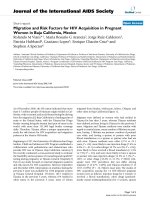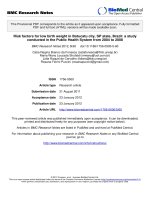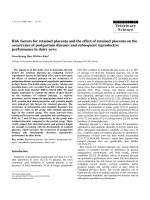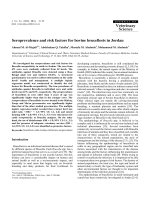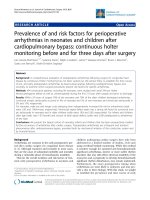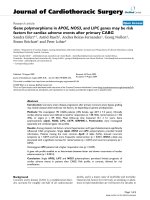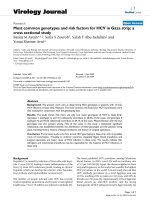Health and lifestyle risk factors for falls in a large population-based sample of older people in Australia
Bạn đang xem bản rút gọn của tài liệu. Xem và tải ngay bản đầy đủ của tài liệu tại đây (481.02 KB, 7 trang )
Journal of Safety Research 45 (2013) 7–13
Contents lists available at SciVerse ScienceDirect
Journal of Safety Research
journal homepage: www.elsevier.com/locate/jsr
Health and lifestyle risk factors for falls in a large population-based sample of older
people in Australia
Rebecca J. Mitchell a,⁎, Wendy L. Watson b, Andrew Milat c, Amy Z.Q. Chung d, Stephen Lord e
a
Falls and Injury Prevention Group, Neuroscience Research Australia, University of New South Wales, Australia
NSW Injury Risk Management Research Centre, University of New South Wales, Australia
Evidence and Evaluation Branch, NSW Ministry of Health, Australia
d
School of Aviation, University of New South Wales, Australia
e
Falls and Balance Research Group, Neuroscience Research Australia, University of New South Wales, Australia
b
c
a r t i c l e
i n f o
Article history:
Received 27 February 2012
Received in revised form 19 September 2012
Accepted 29 November 2012
Available online 14 December 2012
Keywords:
accidental falls
aged
lifestyle
risk factors
health policy
a b s t r a c t
Introduction: Fall-related injuries among older people is a significant public health issue. Method: To identify
medical, general health and lifestyle factors associated with falls and multiple falls in older persons, a representative sample of people aged 65+ years living in the community in New South Wales (NSW) Australia
were surveyed regarding their falls experience, lifestyle and general health. Results: One-quarter of respondents indicated they had fallen in the past 12 months. People who fell were more likely to be aged 85 +
years, have cataracts, musculoskeletal system and connective tissue disorders, major diseases of the circulatory, respiratory and nervous systems, use four or more medications, use a mobility aid and be overweight
than non-fallers. Individuals aged 85+ years and those who experienced circulatory diseases, used four or
more medications and used mobility aids were more likely to experience multiple falls. Discussion: This representative population-based survey reinforces the multi-factorial nature of falls and the complex interaction
of risk factors that increase the likelihood of individuals having a fall or multiple falls. Agencies focused on
community-based fall prevention strategies should adopt a systematic, integrated approach to reduce the
burden of fall injury at the population-level and should have mechanisms in place at the population-level
to monitor the success of fall reduction strategies.
© 2013 National Safety Council and Elsevier Ltd. All rights reserved.
1. Introduction
Fall-related injury morbidity and mortality among older people is a
significant public health issue worldwide (Aschkenasy & Rothenhaus,
2006; Bradley & Pointer, 2009; Peden McGee, & Sharma, 2002). It is estimated that approximately one-third of individuals aged 65 years and
older living in the community fall each year with many older individuals
falling more than once (Campbell, Borrie, & Spears, 1989; Tinetti,
Speechley, & Ginter, 1988). Fall-related injuries among older people represent a significant cost in health care (Schuffham, Chaplin, & Legood,
2003; Stevens, Corso, Finkelstein, & Miller, 2006), with the annual direct
cost to the health system in 2006-07 estimated at $558.5 million in New
South Wales (NSW), the most populous state in Australia, with an estimated 460,000 people aged 65 years and older (Watson, Clapperton, &
Mitchell, 2011).
The causes of falls are multi-factorial, involving both intrinsic and extrinsic factors (Graafmans et al., 1996; Morris et al., 2004). In particular,
fall injury risk has been associated with a number of physical and
⁎ Corresponding author at: Neuroscience Research Australia, University of New South
Wales, Sydney NSW 2052, Australia. Tel.: +61 2 9385 7555; fax: +61 2 9385 6040.
E-mail address: (R.J. Mitchell).
lifestyle-related factors, such as the presence of chronic health conditions,
like stroke, being female, having mobility problems, using multiple medications, alcohol consumption, and a low body mass index (O'Loughlin,
Robitaille, Boivin, & Suissa, 1993; Tinetti et al., 1988; Tinetti, Doucette, &
Claus, 1995). In addition to causing physical injuries, falls can have a detrimental effect on an individuals’ confidence. Following a fall, older people
can develop a fear of falling, often decreasing their levels of activity in an
attempt to prevent further falls (King & Tinetti, 1995).
With the ageing of the population and the growing costs to the health
system of fall-related injuries, government policies have sought to reduce
the fall injury morbidity burden by encouraging participation in activities
that promote healthy ageing that are likely to prevent, or reduce, the
number of fall injuries (Campbell & Robertson, 2010; Scott, Wagar, Sum,
Metcalfe, & Wagar, 2010). These strategies have included encouraging involvement in physical activities, particularly strength and balance exercises, medication reviews and cataract surgery (Gillespie et al., 2009).
In Australia, there have been few attempts at the population-level to
monitor the success of fall reduction strategies by conducting representative population-based surveys to collect information across a range of factors pertinent to falls. In order to create a baseline for monitoring
government strategies to reduce fall injury in NSW, information on lifestyle and health differences between fallers and non-fallers, and between
0022-4375/$ – see front matter © 2013 National Safety Council and Elsevier Ltd. All rights reserved.
/>
8
R.J. Mitchell et al. / Journal of Safety Research 45 (2013) 7–13
of 5,681 older people (aged 65+ years) living in the community, with
a private telephone, were surveyed across NSW regarding their falls experience, knowledge and perception of falls, participation and awareness of physical activity and health status. The full details concerning
the development of the survey and the methods used are described
in full elsewhere (Centre for Health Advancement and Centre for
Epidemiology and Research, 2010) and summarised below and in Fig. 1.
A two-stage sampling process was used, with the sample stratified
by each of the former eight NSW Area Health Services (AHS). Within
each AHS, households were randomly selected using a computergenerated list of telephone numbers. A single respondent was then
randomly selected from each household for a computer-assisted
single fallers and repeat fallers, need to be described. The aim of this paper
is to use such baseline data to compare health and lifestyle factors between fallers and non-fallers and between single and multiple fallers in
persons aged 65 years and over in a population-based sample.
2. Method
2.1. Sampling design
The NSW Falls Prevention Baseline Survey was undertaken in 2009
by the NSW Ministry of Health (Centre for Health Advancement and
Centre for Epidemiology and Research, 2010). A representative sample
Geocoding of the Australia on-disc electronic white
pages telephone book
↓
Percent of telephone numbers with each telephone
prefix by AHS calculated. All prefixes were
expanded with suffixes ranging from 0000 to 9999
Geocoded telephone numbers assigned Statitical
Local Areas and Area Health Services (AHS)
↓
↓
Matching of created telephone numbers to electronic telephone book. All telephone
numbers that matched the electronic telephone book flagged and assigned an AHS
↓
Unlisted telephone numbers assigned to an AHS containing the greatest proportion of
telephone numbers with that prefix
↓
Telephone numbers filtered to eliminate contiguous unused blocks of greater than 10
numbers
↓
Remaining numbers checked against business telephone numbers in the electronic phone
book and eliminated
↓
Telephone numbers randomly sorted by each AHS and a sample identified for interview and
each household sent a letter describing the aims and methods of the survey 2 weeks prior to
any telephone contract. A 1800 telephone number provided for any questions
↓
Households contacted via random digit dialing. Seven call -backs made to contact each
household
↓
n=109,151 telephone calls made.
Of these: n=10,912 unable to contact;
n=42,104 number not connected;
n=6,610 business or institution telephone;
n=6,067 fax number;
n=172 household not in NSW or holiday house;
n=236 away for duration of survey;
n=549 unable to answer (eg. confused, deaf);
n=1,351 non-translated language;
n=3,669 refusal;
n=31,800 no one 65+ years in household
↓
Where more than 1 individual per household was aged 65+ years, random selection of
respondent was conducted
↓
n=5,681 completed telephone calls, with at least n=675 from each AHS. Of these, n=361
completed by proxies and n=5,320 by respondents
Fig. 1. Sampling flow chart.
R.J. Mitchell et al. / Journal of Safety Research 45 (2013) 7–13
telephone interview (CATI). Proxy respondents were chosen for 361
participants who were unable to answer on their own behalf due to
various conditions, such as hearing impairments, poor health, dementia or cognitive impairment (Centre for Health Advancement and
Centre for Epidemiology and Research, 2010).
Interviews were conducted between March and July 2009. Households selected for a telephone interview that had postal addresses in
the electronic phone book were sent a letter describing the aims and
methods of the survey two weeks prior to the initial attempts at telephone contact. Interviews were conducted by trained Health Survey
Program CATI interviewers and by interviewers from McNair Ingenuity Research Ltd. Up to seven call backs were made to establish initial contact with a household and up to five call backs were made to
contact a selected respondent. Almost all respondents (96.0%) were
interviewed in English. Other languages included Arabic, Chinese,
Greek, Italian, and Vietnamese (Centre for Health Advancement and
Centre for Epidemiology and Research, 2010). The survey response
rate was 60.8% (number of completed interviews divided by the completed interviews and refusals) (Centre for Health Advancement and
Centre for Epidemiology and Research, 2010).
9
living in each household, the number of residential telephone connections for the household, and the varying sampling fraction in each AHS.
3. Results
Around one-quarter (25.6%) of older individuals in 2009 indicated
that they had fallen in the preceding 12 months and of these, 38.1%
reported falling more than once. Of all those who fell, 65.9% of falls
resulted in an injury. Of the injurious falls, 19.9% required a visit to
hospital and 10.7% required hospital admission.
3.1. Gender and age
There were no significant differences in the odds of falling for
males and females. Individuals aged 85 years and over had almost
twice the likelihood of falling than those aged in the comparison
group of 65-69 years (OR = 1.93; 95%CI 1.52-2.44, p b 0.0001). For
multiple fallers, individuals aged 70-74 years were around 10% less
likely (OR = 0.89; 95%CI 0.63-1.26, p = 0.03) and individuals aged
85 years and over were one and a half times more likely (OR = 1.66;
95%CI 1.10-2.50, p = 0.01) to fall than single fallers.
2.2. The survey instrument
3.2. Physical co-morbidities
During each interview, information obtained from all respondents
included demographic information on age, gender, and health status,
such as physician-diagnosed co-morbidities, physical activity participation, prescription medication use, alcohol consumption, and
smoking status. Information on fall experience, knowledge and perception of falls was also obtained. Respondents were asked if in the
last 12 months they had suffered a fall (i.e. accidentally lost their balance, tripped or slipped and found themselves on the floor or ground),
how many times they had fallen, how many of the falls resulted in an
injury, how many of the falls resulted in going to hospital, and how
many of the falls resulted in being admitted to hospital. Questions
were field tested prior to use. Identification of risk alcohol drinking
was defined as individuals who drank more than two standard drinks
on any day (the Australian standard drink contains 10 g of alcohol;
equivalent to 12.5 mL of pure alcohol) (National Health and Medical
Research Council, 2009). Identification of individuals who were overweight or obese was conducted using body mass index (BMI) scores
of 25.0 to 29.9 and 30.0 and higher, respectively. Ethics approval
was obtained from the NSW Health's Population and Health Services
Research Ethics Committee (2008/12/114; HREC/08/CIPHS/55).
2.3. Data analysis
Analysis was performed using SAS version 9.1 (SAS Institute, 2003).
The SURVEYFREQ procedure was used to calculate Rao-Scott designadjusted chi-square tests. The SURVEYLOGISTIC procedure was used to
calculate odds ratios and ninety-five percent confidence intervals (95%
CI). The method of purposeful selection was used in order to select the
variables for the multiple variable logistic regression model (Bursac,
Gauss, Williams, & Hosmer, 2008). Initially, a univariate logistic regression model was developed for fallers and non-fallers and for single and
multiple fallers for each variable to determine if it should be included
in the full model, based on its statistical significance at the 0.05 level.
The full multivariate logistic regression model was then developed, and
each included variable was considered for retention in the model based
on its significance, adjusted for age group and gender. Where possible,
physical conditions were combined using International Classification of
Diseases-based categories into diseases of the nervous system, circulatory system, respiratory system, and musculoskeletal system and connective tissue.
Data were stratified by AHS and a sampling weight was applied to
adjust for differences in the probabilities of selection among respondents. These differences were due to the varying number of people
Compared to those who did not report falling in the last 12 months,
those who reported falling in this period had significantly higher odds
of being diagnosed with diabetes, arthritis, osteoporosis, heart disease/
angina, poor circulation in the legs/peripheral vascular disease, reduced
sensation in the legs or feet, stroke, Parkinson's disease, cataracts, emphysema or lung disease, dementia/cognitive impairment/Alzheimer's
disease, and neck and back problems. Those who fell multiple times
had significantly higher odds of being diagnosed with heart disease/
angina, poor circulation in legs/peripheral vascular disease, reduced
sensation in legs or feet, stroke, and cataracts than those who fell
once (Table 1).
3.3. Prescription medications
Fallers were two and a half times more likely to be taking four or
more prescription medications compared to non-fallers (p b 0.0001).
Fallers were regularly consuming a higher proportion of all prescribed
medications, including twice the proportion of tranquillisers and
anti-depressants, than non-fallers. Multiple fallers were significantly
more likely to be taking multiple prescription medications than single
fallers and consumed twice the proportion of sleeping tablets and
anti-depressants compared to single fallers (Fig. 2).
3.4. Health status
Non-fallers and single fallers were significantly more likely to rate
their health as excellent, very good or good compared to fallers and
multiple fallers, respectively (OR= 0.49; 95%CI 0.42-0.57, p b 0.0001
and OR= 0.55; 95%CI 0.43-0.72, p b 0.0001). Non-fallers and single
fallers were also significantly less likely to have to rush unexpectedly
to the toilet to urinate compared to fallers and multiple fallers, respectively (OR = 1.65; 95%CI 1.44-1.89, p b 0.0001 and OR= 1.27; 95%CI
1.00-1.63, p = 0.05).
3.5. Mobility, physical activity and lifestyle
Individuals who fell were over two and a half times more likely to
regularly use mobility aids than non-fallers (pb 0.0001) and multiple
fallers were twice as likely to regularly use mobility aids than single
fallers (pb 0.0001). Non-fallers and single fallers were significantly
more likely to agree that being physically active for 30 minutes or
more each day reduced fall risk compared to fallers (p= 0.006) and
10
R.J. Mitchell et al. / Journal of Safety Research 45 (2013) 7–13
Table 1
Comparison of demographic, co-morbidity, medication and health status characteristics of fallers and non-fallers and single fallers and multiple fallers, NSW Falls Prevention Baseline Survey, 2009.
Non-fallers
%
Fallers
%
Odds
Ratio
Single
fallers %
Multiple
fallers %
Odds
Ratio
Gender
Male
Female
46.1
53.9
44.1
55.9
1
1.01
0.95–1.25
0.24
42.8
57.2
45.8
54.2
1
0.89
0.69–1.13
0.32
Age group
65-69
70-74
75-79
80-84
85+
31.5
24.6
20.2
14.4
9.3
25.0
23.2
21.6
16.1
14.2
1
1.12
1.35
1.41
1.93
0.98–1.43
1.10–1.64
1.14–174
1.52–2.44
0.06
0.95
0.51
b0.0001
26.1
25.2
20.7
16.4
11.6
23.5
20.3
22.7
16.2
17.3
1
0.89
1.22
1.10
1.66
0.63–1.26
0.86–1.74
0.76–1.60
1.10–2.50
0.03
0.6
0.7
0.01
Physical co-morbidities
Diabetes
Arthritis (all types)
Osteoporosis
Heart disease/angina
Poor circulation in legs/peripheral vascular disease
Reduced sensation in legs or feet
High blood pressure
Stroke
Cancer
Parkinson's disease
Cataracts
Emphysema or lung disease
Dementia/Alzheimer's disease/cognitive impairment
Neck and back problems
16.2
47.4
16.7
23.5
17.4
13.0
51.0
7.5
16.3
0.7
35.5
9.2
0.3
1.1
20.1
58.7
21.0
29.7
28.1
21.4
53.5
10.6
18.6
2.4
45.4
13.6
0.8
1.7
1.30
1.57
1.33
1.38
1.85
1.82
1.11
1.46
1.18
3.41
1.51
1.55
2.73
1.77
1.10–1.55
1.37–1.80
1.12–1.57
1.18–1.60
1.58–2.16
1.53–2.17
0.97–1.27
1.16–1.85
0.98–1.40
1.98–5.88
1.32–1.74
1.26–1.91
1.01–6.85
1.01–3.10
0.0027
b0.0001
0.0009
b0.0001
b0.0001
b0.0001
0.14
0.0013
0.075
b0.0001
b0.0001
b0.0001
0.032
0.045
20.2
57.2
19.9
26.6
23.0
18.6
52.0
7.2
18.0
1.9
42.9
12.4
0.9
2.0
19.9
60.9
22.1
33.7
35.3
24.9
56.3
15.8
19.3
3.2
49.0
15.1
0.9
1.2
0.98
1.17
1.14
1.40
1.82
1.45
1.19
2.43
1.09
1.7
1.28
1.26
0.64
0.82
0.73–1.32
0.91–1.50
0.86–1.52
1.08–1.82
1.40–2.38
1.08–1.93
0.93–1.51
1.64–3.58
0.80–1.49
0.78–3.82
1.01–1.63
0.89–1.78
0.16–2.67
0.30–2.26
0.90
0.21
0.37
0.01
b0.0001
0.01
0.16
b0.0001
0.58
0.17
0.05
0.2
0.54
0.7
Number of prescription medications
None
One
Two
Three
Four or more
13.4
14.8
16.6
15.0
39.8
6.8
11.3
14.3
13.8
53.1
1
1.50
1.69
1.81
2.62
1.10–2.03
1.26–2.27
1.35–2.44
2.03–3.39
0.28
0.72
0.24
b0.0001
8.0
14.1
16.0
13.3
48.1
5.0
6.6
11.9
14.9
60.6
1
0.76
1.20
1.81
2.04
0.40–1.44
0.66–2.18
1.00–3.29
1.21–3.45
0.004
0.69
0.02
b0.0001
Health status
Excellent, very good or good rated health status
Incontinence – urgency some/most time
81.3
40.0
68.3
51.3
0.49
1.65
0.42–0.57
1.44–1.89
b0.0001
b0.0001
73.7
49.3
60.9
54.7
0.55
1.27
0.43–0.72
1.00–1.63
b0.0001
0.05
multiple fallers (p= 0.009), respectively. Fallers were more likely to
have participated in some form of balance training in the last week
than non-fallers (p=0.02). The proportion of individuals who smoked,
were risk alcohol drinkers, and who had their eyesight tested in the
last 12 months were similar for all. Fallers and multiple fallers were
significantly more likely to be overweight or obese than non-fallers
(p=0.01) and single fallers (p= 0.04), respectively (Table 2).
Compared to non-fallers, fallers were significantly more likely to
have made some changes to their lifestyle in the last 12 months to prevent falls (pb 0.0001), with fallers reporting a higher proportion now
95% CI
P-value
95% CI
p-value
using a walking aid, having a balance, walking and/or muscle strength
assessment conducted, and beginning balance exercises. Just over
one-third of multiple fallers reported limiting their activities in the
last 12 months to prevent falls and around one-third of multiple fallers
reported commencing using a walking aid (Fig. 3).
3.6. Co-morbidities and medications
The logistic regression analyses revealed the following variables
were significant and independent risk factors for falls: taking four or
Fig. 2. Type of medications prescribed and taken regularly by non-fallers and fallers and single and multiple fallers (% yes).
R.J. Mitchell et al. / Journal of Safety Research 45 (2013) 7–13
11
Table 2
Comparison of physical activity, mobility, and lifestyle characteristics of fallers and non-fallers and single fallers and multiple fallers, NSW Falls Prevention Baseline Survey, 2009.
Physical activity, mobility and lifestyle
Regularly uses mobility aids (eg. cane, walking stick, walker
or frame, mobility scooter)
Agrees being active for 30 minutes a day reduces the risk of a fall
Did balance training each day in last week
Did flexibility activities each day in last week (i.e. tai chi; yoga;
lawn bowls or other types of bowls; dancing)
Did strength or resistance training, such as lifting weights or push
ups each day in last week
Current smoker
Risk alcohol drinking
Overweight (BMI 25.0–29.9) or obese (BMI 30.0 and over)
Had eyesight tested in last 12 months
Lifestyle changes made to prevent falls in last 12 months
Non-fallers
%
Fallers
%
Odds
Ratio
95% CI
P-value
Single
fallers %
Multiple
fallers %
Odds
Ratio
95% CI
p-value
13.5
29.2
2.67
2.26–3.13
b0.0001
22.8
38.0
2.07
1.59–2.70
b0.0001
68.3
1.2
1.1
64.3
2.2
1.1
0.78
1.84
1.05
0.65–0.93
1.10–3.07
0.54–2.04
0.006
0.02
0.89
68.5
1.8
1.5
59.2
2.6
0.6
0.66
1.39
0.39
0.48–0.90
0.62–3.10
0.10–1.55
0.009
0.42
0.18
7.4
2.1
0.8
0.64–1.03
0.08
4.6
3.6
1.27
0.83–1.92
0.27
7.2
13.2
51.8
65.3
78.7
7.0
11.0
55.3
68.5
88.0
0.98
0.82
1.20
1.15
1.99
0.75–1.28
0.66–1.02
1.04–1.38
1.00–1.33
1.63–2.42
0.89
0.07
0.01
0.06
b0.0001
6.7
11.1
53.1
69.1
86.7
7.5
11.1
59.4
67.0
89.7
1.13
0.98
1.32
0.91
1.31
0.70–1.82
0.66–1.45
1.02–1.70
0.71–1.18
1.00–1.92
0.61
0.91
0.04
0.49
0.16
more prescription medications, untreated cataracts and the presence of
circulatory, respiratory, nervous system and musculoskeletal system
and connective tissue diseases. The model for multiple falls (compared
to a single fall) included taking four or more prescription medications,
untreated cataracts and the presence of circulatory diseases. (Table 3).
4. Discussion
The growth of the ageing population has resulted in an increase
in the incidence of fall-related injury requiring hospitalisation in a
number of countries (Bradley & Pointer, 2009; Scott et al., 2010).
Fall-related injury morbidity and recurrent falls can leave older individuals with ongoing health concerns and impaired mobility
which can adversely impact on their quality of life (Pinheiro,
Ciconelli, Martini, & Ferraz, 2010). To ensure that older individuals
have the best opportunity to remain in their own home with no detrimental impact on their quality of life, there is a need to reduce the incidence of fall injuries in older age. In order to achieve this, fall-related
risk factors need to be addressed and community-wide, as well as individually focused, preventive strategies need to be implemented and
their impact evaluated (Australian Commission on Safety and Quality
in Health Care, 2009).
In the current study, one-quarter of respondents fell once and over
a third (38.1%) of these fell more than once in the last 12 months.
Two-thirds of the reported falls resulted in injury and of those injured,
one in five went to hospital for treatment and one in ten was admitted
to hospital. Similar proportions of falls have been found in other studies in the United States, where 32% of individuals aged 75 years and
over reported falling at least once in the last year (Tinetti et al.,
1988) and in Montreal where 29% of individuals aged 65 years and
over reporting falling in the last 12 months; 18% of all respondents
reported falling once and 12% fell twice or more (O'Loughlin et al.,
1993).
Similar to other studies (O'Loughlin et al., 1993; Morris et al.,
2004), females reported experiencing more falls than males. However, like O'Loughlin et al. (1993), the current study identified no significant differences in the proportion of males and females that reported
multiple falls. This is unlike Morris et al. (2004) and Graafmans et al.
(1996) who found higher proportions of females experiencing two or
more falls. In the current study, individuals aged 85 years and over
had twice the odds of falling compared to those aged 65-69 years
and were almost one and a half times more likely to have multiple
falls. As individuals age, the number of fall-related risk factors increase, contributing to the increased rate of fall-related injuries
(O'Loughlin et al., 1993).
In general, fallers were more likely to have co-morbidities than
non-fallers, with fallers three and a half times more likely to have
Parkinson's disease than non-fallers. Other studies have also found
Parkinson's disease to be associated with fall risk (Cesari et al.,
2002). Individuals with Parkinson's disease often experience postural
instability, difficulty rising from low chairs, and a shuffling gait which
are all likely to affect mobility and balance (Aita, 1982). Compared to
non-fallers, fallers were over 2.5 times more likely to experience
some form of dementia, cognitive impairment or Alzheimer's disease.
Other studies have also found a similar risk of falls for individuals with
dementia (Tinetti et al., 1988; van Doorn et al., 2003; Anstey, von
Sanden, & Luszcz, 2006). Multiple fallers were almost 2.5 times more
likely to have had a stroke than single fallers. Likewise Graafmans
et al. (1996), in a prospective study of falls, found recurrent fallers almost 3.5 times more likely to have had a stroke than non-fallers and
Fig. 3. Type of lifestyle changes made in the last 12 months to prevent falls by non-fallers and faller and single and multiple fallers (% yes).
12
R.J. Mitchell et al. / Journal of Safety Research 45 (2013) 7–13
Table 3
Major medical and medication-related risk factors for falls, NSW Falls Prevention Baseline Survey 2009.
Adjusted
95%CI
Odds Ratio
p-value
Fallers and non-fallers
Diabetes
Musculoskeletal system and connective tissue1
Circulatory system2
Cataracts
Respiratory system3
Nervous system4
Four or more medications
1.16
1.42
1.39
1.24
1.32
2.75
1.24
0.96–1.39
0.12
1.22–1.87 b0.0001
1.20–1.62 b0.0001
1.06–1.44
0.006
1.06–1.64
0.01
1.68–4.51 b0.0001
1.06–1.46
0.007
Multiple fallers and single fallers
Circulatory2
Cataracts
Four or more medications
1.44
1.13
1.43
1.10–1.87
0.87–2.14
1.10–1.86
0.008
0.36
0.008
1
Includes arthritis, osteoporosis and neck and back problems.
Includes heart disease/angina, poor circulation in legs, peripheral vascular disease,
reduced sensation in legs or feet and stroke.
3
Includes emphysema or lung disease.
4
Includes dementia, Alzheimer's disease, cognitive impairment, Parkinson's disease.
2
single fallers combined. At a population-level, tailored interventions of a
multi-factorial nature may be of benefit for health conditions, such as
nervous system diseases (Shaw & Kenny, 1988), especially with the
growth of dementia suffers aged 65 years and over in Australia set to
double from 212,000 in 2011 to 452,600 by 2031 (Australian Institute
of Health and Welfare, 2007).
Individuals using four or more medications had an increased risk of
falling compared to non-fallers and of having multiple falls compared
to a single fall. Polypharmacy increases the risk of falling, with the use
of four or more medications an indicator of falls risk (Tinetti, 2003).
Fallers and multiple fallers were more likely to be taking psychoactive
medications, such as anti-depressants, compared to non-fallers and
single fallers, respectively. Where possible, mechanisms to decrease
medication load among older individuals need to be considered and
medication reviews promoted (Tinetti, 2003). How this strategy is
implemented at a population-level becomes less clear as voluntary annual health assessments for those aged 75 years and over in Australia
are only accessed by 191 in every 1,000 individuals (Australian
Institute of Health and Welfare, 2007).
While the older people surveyed recognised that 30 minutes of exercise a day was a preventive factor for falling, their ability to put this
knowledge into practice was not evident. When asked about the physical activities that they had conducted in the last week, only 2% of individuals who fell reported participating in any balance, flexibility or
strength enhancing activities. This suggests a need to increase opportunities for strength and balance enhancing activities in this age
group, possibly through greater advertising of activities for older individuals and their health benefits.
Self-reported smoking or drinking behaviours were similar for
fallers and non-fallers alike. Tinetti et al. (1988) also found a similar
likelihood of smoking and drinking behaviours reported by fallers
and non-fallers and hypothesised that heavy smokers and high risk
drinkers were more likely to have early deaths and not reach older
age. On the other hand, Peel et al. (Peel, Bartlett, & McClure, 2007)
found a protective effect for some lifestyle-related behaviours, such
as not smoking, moderate alcohol consumption and being active,
and the risk of fall-related hip fracture. However, hip fracture is one
of the more serious injuries following a fall and this study included
both serious and non-serious injuries.
Limitations of the current study include the self-reported nature
of the data and the possibility of recall bias associated with respondents reporting events over a 12 month period, compared to other
methods, such as weekly or monthly diaries or telephone calls
(Ganz, Higashi, & Rubenstein, 2005). It is also well known that
cognitive deficits associated with age can undermine the validity of
self reported survey measures (New England States Consortium,
2001). However, to minimise its impact survey items were pretested,
interviewers were trained and proxy respondents were used, all measures consistent with international survey best practice (New England
States Consortium, 2001). There were no physiological measurements
or mobility examinations conducted to verify the conditions reported,
nor were all vision problems identified, such as glaucoma and macular
degeneration, despite vision problems being an important risk factor
for falls (Tinetti et al., 1988).
This study demonstrates the ability to achieve population-level
baseline data to monitor the future impact of fall injury reduction
strategies in NSW. Initial investment in fall injury prevention in
NSW has seen the development of a statewide policy for fall injury
prevention (NSW Health Department, 2011), the establishment of a
statewide and 8 AHS fall coordinator positions and promotion of balance and strength training programs (NSW Health Department,
2011). The baseline results reinforce the multi-factorial nature of
falls causalities and the complex interaction of risk factors that increase the likelihood of individuals having a fall or multiple falls. In
addition, the consistency in the findings of this study with previous research may suggest that the aetiology of falls in community-dwelling
older people in developed countries is relatively stable. Findings also
strengthen the case for developing different strategies to address the
needs of sub-populations as it is clear that risk factors vary between
single and multiple fallers. The complexity of the issue has meant
that, while research has identified a number of efficacious interventions that can significantly decrease the incidence of falls, costeffective fall prevention programs at the population-level has been
more difficult to demonstrate. The implementation and evaluation of
fall injury prevention strategies at the population-level requires an integrated approach across all settings and health care providers, as well
as more effective partnerships with older adults and their caregivers. As
Ganz et al. points out, “It takes a village of stakeholders working together
to prevent falls and reduce fall risk, tasks that no one stakeholder can
accomplish alone” (Ganz, Alkema, & Wu, 2008).
Acknowledgements
R Mitchell was supported by an ARC-linkage post-doctoral fellowship (LP0990057) and the NSW Ministry of Health. W Watson was
supported by the NSW Ministry of Health.
The authors would like to thank the Centre for Population Health
and the Centre for Epidemiology and Evidence at the NSW Ministry
of Health for providing access to the NSW Falls Prevention Baseline
Survey data analysed in this study.
References
Aita, J. (1982). Why patients with Parkinson's disease fall. Journal of the American Medical Association, 247(4), 515–516.
Anstey, K., von Sanden, C., & Luszcz, M. (2006). An 8-year prospective study of the relationship between cognitive performance and falling in very old adults. Journal of
the American Geriatrics Society, 54, 1169–1176.
Aschkenasy, M. T., & Rothenhaus, T. C. (2006). Trauma and falls in the elderly. Emergency Medicine Clinics of North America, 24(2), 413–432.
Australian Commission on Safety and Quality in Health Care (2009). Preventing falls and
harm from falls in older people best practice guidelines for Australian community care.
Canberra: Commonwealth of Australia.
Australian Institute of Health and Welfare (2007). Older Australia at a glance (4th ed.).
Canberra: Australian Institute of Health and Welfare.
Bradley, C., & Pointer, S. (2009). Hospitalisations due to falls by older people, Australia,
2005-06. Injury research and statistics series no. 50. Adelaide: AIHW.
Bursac, Z., Gauss, C., Williams, D., & Hosmer, D. (2008). Purposeful selection of variables
in logistic regression. Source Code for Biology and Medicine, 3(17).
Campbell, A. J., Borrie, M. J., & Spears, G. F. (1989). Risk factors for falls in a
community-based prospective study of people 70 years and older. Journal of Gerontology, 44(4), M112–M117.
Campbell, A. J., & Robertson, M. C. (2010). Comprehensive approach to fall prevention
on a national level: New Zealand. Clinics in Geriatric Medicine, 26(4), 719–731.
R.J. Mitchell et al. / Journal of Safety Research 45 (2013) 7–13
Centre for Health Advancement, & Centre for Epidemiology and Research (2010). NSW
falls prevention baseline survey. North Sydney: NSW Department of Health.
Cesari, M., Landi, F., Torre, S., Onder, G., Lattanzio, F., & Bernabei, R. (2002). Prevalence
and risk factors for falls in an older community-dwelling population. Journals of
Gerontology Series a-Biological Sciences and Medical Sciences, 57(11), M722–M726.
Ganz, D., Alkema, G., & Wu, S. (2008). It takes a village to prevent falls:
reconceptualizing fall prevention and management for older adults. Injury Prevention, 14, 266–271.
Ganz, D., Higashi, T., & Rubenstein, L. (2005). Monitoring falls in cohort studies of
community-dwelling older people: Effect of the recall interval. Journal of the American Geriatric Society, 53, 2190–2194.
Gillespie, L., Robertson, M., Gillespie, W., Lamb, S., Gates, S., Cumming, R., & Rowe, B.
(2009). Interventions for preventing falls in older people living in the community. Cochrane Database of Systematic Reviews 2009, 2(Art. No.: CD007146).
/>Graafmans, W. C., Ooms, M. E., Hofstee, H. M., Bezemer, P. D., Bouter, L. M., & Lips, P.
(1996). Falls in the elderly: A prospective study of risk factors and risk profiles.
American Journal of Epidemiology, 143(11), 1129–1136.
King, M., & Tinetti, M. (1995). Falls in community-dwelling older persons. Journal of the
American Geriatrics Society, 43(10), 1146–1154.
Morris, M., Osborne, D., Hill, K. D., Kendig, H., Lundgren-Lindquist, B., Browning, C., & Reid, J.
(2004). Predisposing factors for occasional and multiple falls in older Australians who
live at home. Australian Journal of Physiotherapy, 50(3), 153–159.
National Health and Medical Research Council (2009). Australian guidelines to reduce
health risks from drinking alcohol. Canberra: National Health and Medical Research
Council.
New England States Consortium (2001). Designing effective survey methods for frail elders symposium proceedings: MMIP technical assistance paper no. 11. Baltimore: University of Maryland.
NSW Health Department (2011). Prevention of falls and harm from falls among older
people: 2011-2015. North Sydney: NSW Health Department.
O'Loughlin, J., Robitaille, Y., Boivin, J., & Suissa, S. (1993). Incidence of and risk factors
for falls and injurious falls among the community-dwelling elderly. American Journal of Epidemiology, 137(3), 342–354.
Peden, M., McGee, K., & Sharma, G. (2002). The injury chart book: a graphical overview of
the global burden of injuries. Geneva: World Health Organization.
Peel, N. M., Bartlett, H. P., & McClure, R. J. (2007). Healthy aging as an intervention to
minimize injury from falls among older people. In N. J. Weller, & S. I. S. Rattan
(Eds.), Healthy Aging and Longevity, Vol. 1114. (pp. 162–169). Oxford: Blackwell
Publishing.
Pinheiro, M. D., Ciconelli, R. M., Martini, L. A., & Ferraz, M. B. (2010). Risk factors for recurrent falls among Brazilian women and men: The Brazilian Osteoporosis Study
(BRAZOS). Cadernos De Saude Publica, 26(1), 89–96.
SAS Institute (2003). SAS: statistical software, version 9.1. Cary, North Carolina: SAS Institute.
Schuffham, P., Chaplin, S., & Legood, R. (2003). Incidence and costs of unintentional
falls in older people in the United Kingdom. Journal of Epidemiology and Community
Health, 57, 740–744.
Scott, V., Wagar, B., Sum, A., Metcalfe, S., & Wagar, L. (2010). A public health approach
to fall prevention among older persons in Canada. Clinics in Geriatric Medicine,
26(4), 705–718.
Shaw, F., & Kenny, R. (1988). Can falls in patients with dementia be prevented? Age and
Ageing, 27, 7–9.
Stevens, J., Corso, P., Finkelstein, E., & Miller, T. (2006). The costs of fatal and non-fatal
falls among older adults. Injury Prevention, 12, 290–295.
Tinetti, M., Doucette, J., & Claus, E. (1995). The contribution of predisposing and situational risk factors to serious fall injuries. Journal of the American Geriatrics Society,
43(11), 1207–1213.
13
Tinetti, M., Speechley, M., & Ginter, S. (1988). Risk factors for falls among elderly persons
living in the community. New England Journal of Medicine, 319(26), 1701–1707.
Tinetti, M. E. (2003). Preventing falls in elderly persons. New England Journal of Medicine, 348(1), 42–49.
van Doorn, C., Gruber-Baldini, A., Zimmerman, S., Hebel, J., Port, C., Baumgarten, M.,
Quinn, C., Taler, G., May, C., & Magaziner, J. (2003). Dementia as a risk factor for
falls and fall injuries among nursing home residents. Journal of the American Geriatrics Society, 51, 1213–1218.
Watson, W. L., Clapperton, A., & Mitchell, R. (2011). The burden of fall-related injury
among older persons in New South Wales. Australian and New Zealand Journal of
Public Health, 35(2), 170–175.
Rebecca Mitchell is a Senior Research Fellow at the Falls and Injury Prevention Group at
Neuroscience Research Australia, University of New South Wales. Her primary research
interests include evaluative tool development, data linkage studies, trauma services
research, injury policy, and epidemiological and evaluation studies, predominantly in
the areas of occupational health, road trauma, patient safety, sport and water safety,
and falls injury prevention. Previously, she worked as a Senior Policy Analyst in the
Injury Prevention and Policy Branch of the NSW Ministry of Health and as a Senior
Officer in the Epidemiology Unit at the National Occupational Health and Safety
Commission.
Wendy Watson was formerly a Senior Research Fellow at the NSW Injury Risk Management Research Centre at the University of New South Wales where her role includes the
development and management of the evaluation of the NSW State Falls Prevention policy. She has 20 years experience in injury prevention research and her main areas of interest include epidemiologic analysis of injury surveillance data, monitoring and
evaluation of injury prevention programs and policy and measuring the burden of injury at the population level. She previously worked at the Monash University Accident
Research Centre across a wide variety of injury prevention research issues.
Andrew Milat is a policy maker come intervention researcher with almost 20 years experience in the design, implementation and evaluation of innovative health policies and
programs at national, state and local levels. His research interests are centred around
implementation science in public health and he has published widely in the areas of tobacco control, obesity prevention and falls prevention. He is currently an Investigator
on three National Health and Medical Research Council Grants focusing implementation science, translational research and research impact assessment. He has worked
as a Regional Director of Health Promotion, Head of the Sax Institute's Knowledge
Transfer Division and is currently the Manager of Evidence and Evaluation Branch in
NSW Ministry of Health, Australia. His extensive experience across levels of government and wide ranging experience in intervention research provides him with unique
appreciation of the interface between research, policy and practice
Amy Chung is a Research Assistant at the School of Aviation at the University of New
South Wales. She is a Registered Psychologist and has a Masters degree in Organisational
Psychology. She is currently completing her PhD on the research-practice gap and barriers
to research application in human factors and ergonomics.
Stephen Lord is a Senior Principal Research Fellow at Neuroscience Research Australia,
University of New South Wales. He trained in biology, physiology and psychology at the
University of Sydney and undertook his PhD and DSc degrees at the University of New
South Wales. His research interests include understanding balance, indentifying risk factors for falls, fall risk assessments, interventions to prevent falls and translational research
including incorporation of validated fall risk assessments into routine practice and
implementing evidence-based exercise findings into fall prevention Programs.

